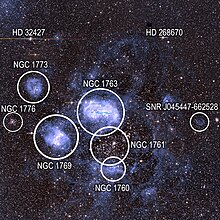
NGC 1761 (also known as GC 980, JH 2710, LH 9)[3] is an open cluster in the Dorado constellation in the Large Magellanic Cloud. It encompasses a group of about 50 massive hot young stars. These stars are among the largest stars known anywhere in the Universe and appear as bright blue-white in colour. The stars in turn have given birth to new stars within dark globules. NGC 1761 is particularly noteworthy for its intense ultraviolet radiation, which has eroded a large hole in the surrounding nebular material. It is similar in structure to the more famous Rosette Nebula. [4][5][6]
It is part of a large region of stars called LMC-N11 (N11) which was discovered with a 23-cm telescope by the astronomer James Dunlop in 1826 and was also observed by John Herschel in 1835.[3]
References
- ^ a b "NGC 1761 -- Association of Stars". Simbad. Retrieved 27 April 2024.
- ^ a b "NED results for object NGC 1761". NASA/IPAC EXTRAGALACTIC DATABASE. Retrieved 27 April 2024.
- ^ a b c "NGC 1761". cseligman. Retrieved 27 April 2024.
- ^ "Spectacular Space Bubble Photographed by Hubble". space.com. 22 June 2010. Retrieved 27 April 2024.
- ^ "NGC 1760, a large emission nebula in the Large Magellanic Cloud". Anne's Astronomy News. Retrieved 27 April 2024.
- ^ "NGC 1760 & NGC 1747 in the LMC". Astrobin. Retrieved 27 April 2024.
External links
 Media related to NGC 1761 at Wikimedia Commons
Media related to NGC 1761 at Wikimedia Commons









You must be logged in to post a comment.